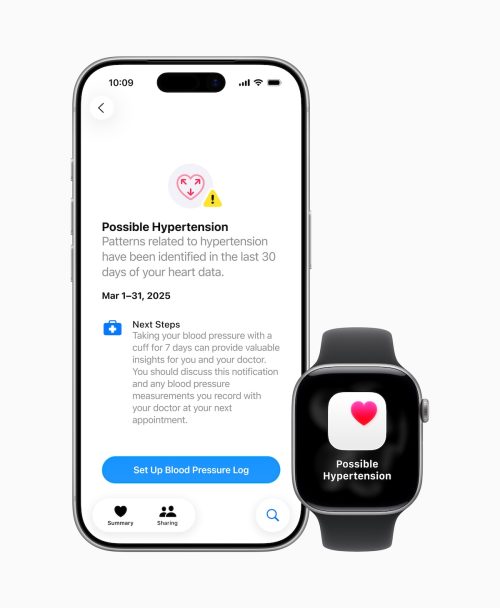Your Apple Watch Launched a New Life-Saving Feature This Week — Best Life
The Apple Watch is equipped with several safety features, including fall detection, crash detection, a siren, and a medical ID page that displays on your lock screen. Plus, it offers a slew of health features, such as menstrual cycle tracking, sleep tracking, and a medications app. There’s also a heart health app that can alert you to high or low heart rates, or irregular heart rhythms that may signal atrial fibrillation (AFib). Now, Apple Watch has come out with a new heart-based health metric that could very well save your life.
RELATED: If You’re Over 65, This Is Your Ideal Resting Heart Rate—And Why It Matters.
The FDA just approved Apple Watch’s new hypertension feature.
 Apple
Apple
On Sept. 11, the U.S. Food & Drug Administration (FDA) cleared a new hypertension (high blood pressure) notification feature for Apple Watch.
The announcement was made alongside the unveiling of the new Apple Watch Ultra 3 and Apple Watch Series 11, both of which are available now and include the new hypertension feature. The feature is also available on Apple Watch Series 9 and later, and Apple Watch Ultra 2 and later, with watchOS 26.
As the American Heart Association (AHA) explains, a traditional blood pressure reading consists of systolic blood pressure (the upper number, which “measures the pressure your blood is pushing against your artery walls when the heart beats) and diastolic blood pressure (the lower number, which “measures the pressure your blood is pushing against your artery walls while the heart muscle rests between beats”).
It’s important to understand that the Apple Watch does not provide these readings and cannot diagnose high blood pressure.
Rather, the watch has an optical heart sensor that uses light to detect “the amount of blood flowing through your wrist at any given moment,” as Apple explains. “By flashing its LED lights hundreds of times per second, Apple Watch can calculate the number of times the heart beats each minute—your heart rate.”
The hypertension feature uses this data and then analyzes how your blood vessels contract and expand in response to these heartbeats. “The algorithm works passively in the background, reviewing data over 30-day periods, and will notify users if it detects consistent signs of hypertension,” states a press release.
RELATED: 100s of Thousands of Americans Could Be Saved by 7 New Blood Pressure Guidelines.
This feature is potentially life-saving.In the U.S., nearly half of adults have hypertension. Of these roughly 120 million people, nearly 60 percent are unaware that they have high blood pressure.
This is a scary statistic considering that hypertension significantly increases the risk of heart attack and stroke, two of the leading causes of death in the nation. In 2023, “high blood pressure was a primary or contributing cause of 664,470 deaths in the United States,” according to the Centers for Disease Control & Prevention (CDC).
“Hypertension is the leading preventable cause of heart attack and stroke, yet millions remain undiagnosed,” Harlan Krumholz, MD, SM, a cardiologist and scientist at Yale University and Yale New Haven Hospital, said in a statement to Apple. “Making accurate detection easy and part of daily life can help people get care earlier and prevent avoidable harm.”
Therefore, if an Apple Watch user receives a hypertension alert, it’s recommended that they use a traditional blood pressure cuff to track their readings for seven days, followed by an appointment with their healthcare provider.
The benefits of this feature aren’t strictly anecdotal, either.
“The feature was developed with advanced machine learning and training data from multiple studies totaling over 100,000 participants,” states Apple. “Its performance was then validated in a clinical study of over 2,000 participants.”
In this study, the hypertension alerts from Apple Watch were just as accurate as a blood pressure cuff.
RELATED: 6 Things You Never Knew You Could Do With Your Smartwatch.
The heart rate feature is important, too.In addition to consistently monitoring your blood pressure, knowing your resting heart rate can also provide valuable insight into your heart health.
“A persistently high heart rate can put excessive strain on the heart, increasing the risk of high blood pressure, heart failure, stroke, and heart attacks,” Erin Barrett, PhD, director of product innovation and scientific affairs at Shaklee, previously explained to Best Life.
“A consistently low heart rate can result in inadequate oxygen delivery to the brain and other organs, potentially causing fainting, confusion, and, in severe cases, heart failure,” she added.
However, as with all health features on Apple Watch, it is not a substitute for regular and recommended doctor’s appointments.
We offer the most up-to-date information from top experts, new research, and health agencies, but our content is not meant to be a substitute for professional guidance. When it comes to the medication you're taking or any other health questions you have, always consult your healthcare provider directly.